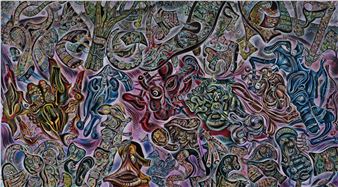Behind the Beyond: Psychedelic Posters and Fashion in San Francisco, 1966-71
The Hallie Ford Museum of Art at Willamette University is pleased to present a major exhibition, Behind the Beyond: Psychedelic Posters and Fashion in San Francisco, 1966-71, opening June 3 and continuing through August 27, 2017, in the Melvin Henderson-Rubio Gallery and the Maribeth Collins Lobby.
Organized by artist Gary Westford and drawn from his extensive personal collection in celebration of the 50th anniversary of ÔÇ£The Summer of Love,ÔÇØ this exhibition features more than 100 iconic posters, historic photographs, and related ephemera that highlight the development of the ÔÇ£psychedelicÔÇØ art style. Twenty examples of clothing chart the influence of psychedelia on the worlds of both street and high fashion. The exhibition will also feature a light show by Bill Ham who created the revolutionary swirling backdrops to many legendary rock concerts of the time. This exhibition is accompanied by a variety of lectures, films, and gallery talks, as well as a childrenÔÇÖs art camp (more details).
The 1960s was a radical and cultural watershed period in American history. The civil rights, womenÔÇÖs liberation, and LGBTQ movements, as well as the sexual revolution and widespread opposition and polarization regarding the Vietnam War, led to a search for new societal, cultural, and individual identities. This search would lead 20,000 Americans from various walks of life to attend ÔÇ£A Gathering of the Tribes for a Human Be-In,ÔÇØ a happening held in San FranciscoÔÇÖs Golden Gate Park on January 14, 1967. The ÔÇ£Summer of LoveÔÇØ would soon follow as the streets of the city overflowed with people eager to proclaim a new ÔÇ£counterculturalÔÇØ order.
It was against this backdrop that a new ÔÇ£psychedelicÔÇØ culture, music, fashion, and poster scene would form, with music provided by San Francisco bands including The Grateful Dead, Jefferson Airplane, Santana, and Quicksilver Messenger Service, among many others. A radical new breed of poster-makers, including Victor Moscoso, Wes Wilson, Stanley Mouse, Alton Kelley, Rick Griffin, David Singer, and Bonnie MacLean, would develop an innovative design style that featured ballooned lettering fonts, dissonant color, and references to Pop and Op art as well as Art Nouveau. The ÔÇ£San Francisco SoundÔÇØ and revolution in poster-making had begun.

Recommended for you
The Hallie Ford Museum of Art at Willamette University is pleased to present a major exhibition, Behind the Beyond: Psychedelic Posters and Fashion in San Francisco, 1966-71, opening June 3 and continuing through August 27, 2017, in the Melvin Henderson-Rubio Gallery and the Maribeth Collins Lobby.
Organized by artist Gary Westford and drawn from his extensive personal collection in celebration of the 50th anniversary of ÔÇ£The Summer of Love,ÔÇØ this exhibition features more than 100 iconic posters, historic photographs, and related ephemera that highlight the development of the ÔÇ£psychedelicÔÇØ art style. Twenty examples of clothing chart the influence of psychedelia on the worlds of both street and high fashion. The exhibition will also feature a light show by Bill Ham who created the revolutionary swirling backdrops to many legendary rock concerts of the time. This exhibition is accompanied by a variety of lectures, films, and gallery talks, as well as a childrenÔÇÖs art camp (more details).
The 1960s was a radical and cultural watershed period in American history. The civil rights, womenÔÇÖs liberation, and LGBTQ movements, as well as the sexual revolution and widespread opposition and polarization regarding the Vietnam War, led to a search for new societal, cultural, and individual identities. This search would lead 20,000 Americans from various walks of life to attend ÔÇ£A Gathering of the Tribes for a Human Be-In,ÔÇØ a happening held in San FranciscoÔÇÖs Golden Gate Park on January 14, 1967. The ÔÇ£Summer of LoveÔÇØ would soon follow as the streets of the city overflowed with people eager to proclaim a new ÔÇ£counterculturalÔÇØ order.
It was against this backdrop that a new ÔÇ£psychedelicÔÇØ culture, music, fashion, and poster scene would form, with music provided by San Francisco bands including The Grateful Dead, Jefferson Airplane, Santana, and Quicksilver Messenger Service, among many others. A radical new breed of poster-makers, including Victor Moscoso, Wes Wilson, Stanley Mouse, Alton Kelley, Rick Griffin, David Singer, and Bonnie MacLean, would develop an innovative design style that featured ballooned lettering fonts, dissonant color, and references to Pop and Op art as well as Art Nouveau. The ÔÇ£San Francisco SoundÔÇØ and revolution in poster-making had begun.
Contact details















